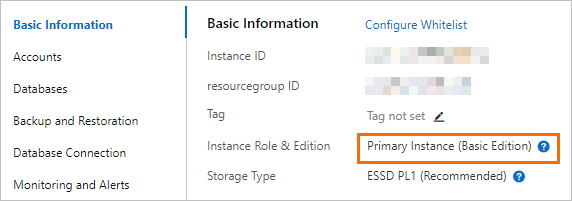ApsaraDB RDS offers the following editions: Basic Edition, High-availability Edition, and Cluster Edition. This topic describes the editions and the scenarios of each edition. This topic also describes how to view and change the edition of an RDS instance.
Description of editions
| RDS edition | Configuration | Scenarios | Supported engine |
|---|---|---|---|
| RDS Basic Edition |
|
|
|
| RDS High-availability Edition |
|
|
|
| RDS Cluster Edition |
|
|
|
View the edition of an RDS instance

Change the edition of an RDS instance
| Database engine | Edition change description |
|---|---|
| MySQL | If your RDS instance runs one of the following major engine versions and RDS editions, you can upgrade the RDS instance from RDS Basic Edition to RDS High-availability Edition. For more information, see Upgrade an ApsaraDB RDS for MySQL instance from Basic Edition to High-availability Edition.
If your RDS instance runs one of the following major engine versions and RDS editions, you can upgrade the RDS instance from RDS High-availability Edition to RDS Cluster Edition. For more information, see Upgrade an ApsaraDB RDS for MySQL instance from RDS High-availability Edition to RDS Cluster Edition.
|
| SQL Server | If your RDS instance runs one of the following major engine versions and RDS editions, you can upgrade the RDS instance from RDS Basic Edition to RDS High-availability Edition. For more information, see Upgrade an ApsaraDB RDS for SQL Server instance from Basic Edition to High-availability Edition.
|
If your RDS instance runs SQL Server 2008 R2 with local disks, you can upgrade the RDS instance to SQL Server 2012 or SQL Server 2016. For more information, see Upgrade an ApsaraDB RDS for SQL Server instance with local SSDs from SQL Server 2008 R2 to SQL Server 2012 or SQL Server 2016. | |
| PostgreSQL | If your RDS instance runs one of the following database versions and RDS editions, you can upgrade the RDS instance from RDS Basic Edition to RDS High-availability Edition. For more information, see Upgrade an ApsaraDB RDS for PostgreSQL instance from Basic Edition to High-availability Edition.
|
Instance types supported by various RDS editions
For more information about the instance types that are supported by various RDS editions, see ApsaraDB RDS instance families.
Features supported by various RDS editions
For more information about the features that are supported by various RDS editions, see Features.













Was this helpful?